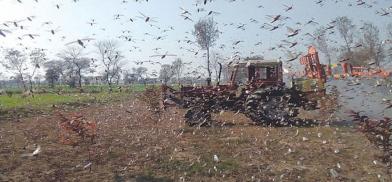Major locust swarms may reach Pakistan later this month
Officials on Thursday warned that the next few weeks could be crucial in the fight against desert locust infestation with major swarms expected to be reaching Pakistan later this month from the Horn of Africa

Officials on Thursday warned that the next few weeks could be crucial in the fight against desert locust infestation with major swarms expected to be reaching Pakistan later this month from the Horn of Africa.
They are confident that the country is much better prepared to deal with the short-horned grasshoppers, considered as one of the most voracious insects, this time than the last major attack here in 1993, but the shortage of resources could impede the effort to contain the problem.
Chairman of the National Disaster Management Authority Lt Gen Mohammad Afzal, while briefing the diplomatic corps at the National Locust Control Centre (NLCC), said the locust problem is likely to peak in the next three to four weeks. “Next eight weeks between July 15 and Sept 15 would be critical because of monsoon and the government’s ongoing commitment with anti-Covid-19 measures.”
Pakistan is on the locust migratory route and has both summer and spring breeding areas. Therefore, it is particularly prone to locust attacks and has over the years suffered several outbreaks. The latest episode here began in June last year following the start of climate change-induced international locust crisis in 2018 from the southern Arabian Peninsula’s Empty Quarter bordering Yemen, Saudi Arabia and Oman.
This year was expected to be the worst for Pakistan in 27 years because of longer than usual monsoon in 2019 and more rain towards its end due to Indian Ocean Dipole – a sea warming phenomenon. Therefore, because of favourable conditions three generations of breeding occurred. The capacity to deal with the emerging problem too was very low last year.
Meanwhile, the continuing surge in locust numbers in Horn of Africa, Yemen and other countries in the region posed a serious threat of invasion.
It was initially believed that things on the locust front could begin going bad from June. But, so far it hasn’t happened.
“We haven’t had that number of locusts coming here as we were expecting from June 22 to July 10. Their numbers were far less. And whatever numbers came, most of them have crossed over to India,” Gen Afzal said.
It possibly occurred due to effective control measures, migration of most of the spring bred swarms towards India and relatively dry conditions in southern Iran and southwest Pakistan during June, which caused the vegetation to dry up especially in Balochistan.
NLCC’s Deputy Coordinator Maj Gen Saeed Akhtar also observed that migration from Iran had lately subsided, but Pakistan is still not out of danger.
Within the country, adult groups and swarms were forming in parts of Khyber Pakhtunkhwa, which received light rains during June. Those groups and swarms are now expected to move towards Cholistan, according to a forecast of the Food and Agriculture Organisation (FAO). Moreover, with the onset of monsoon rains, breeding is likely to begin in areas near to Pak-India border.
The FAO fears that locust numbers could grow twenty-fold in the upcoming monsoon season unless extra measures are undertaken to counter the swarms.
Meanwhile, small groups formed through breeding in southern Afghanistan are likely to transit through Pakistan. Similarly, the FAO predicts that a limited number of small swarms formed in Iran’s Sistan-Baluchestan province and South Khorasan too would move to the summer breeding grounds in Pakistan.
The bigger threat, however, is from the swarms currently concentrated in north Somalia, which are expected to begin reaching here in the next few weeks.
Ministry of Food Security and Research Secretary Omar Hamid Khan said the swarms coming from the Horn of Africa could be 400 times more than those that came last year.
Mr Khan fears unless a miracle occurs the major swarms from the Middle East, Oman, and Africa will be coming through Pakistan’s coastline. “We could be under attack from all these sides. This could be in the next two weeks,” he worries.
Moreover, he warns that the swarms that have already entered India could also turn back. Expected locust invasions from Iran and Afghanistan are in addition to that. “We could be facing them in a big way up to September and beyond,” he maintained.
Director General at the UN Division of the Foreign Office Farrukh Iqbal also warned that the situation was likely to worsen.
“If steps are not taken, the situation would be a cause of concern not only for Pakistan but also for the region’s food security,” he said echoing FAO, which too has warned of growing threats to food security in South-West Asia.
Losses: Minister for Food Security Fakhr Imam said the damage caused by locusts to crops last year was marginal and luckily the wheat crop remained unaffected. He said the wheat production was about 1.5 million tons less than the target, but that shortfall was because of climate change and not locust attack.
Secretary Khan gave various estimates about the expected losses to agriculture due to locust attack. He said the losses of major crops could be between a minimum of Rs490 billion and in the worst-case scenario of up to Rs2,451.5bn.
Talking about the measures taken by the government, Mr Imam said a lot of emphasis is being placed by the government on capacity building for fighting the infestation. He said Rs26bn is expected to be spent by the federal and provincial governments this year to tackle the problem. Additionally, soft loans are being acquired through the World Bank.
The food security secretary pointed out that there was a huge funding gap of Rs57,050m in the expenditures calculated for the next three years, which could “not only limit locust control efforts, but could also result in locust upsurges, invasions, and outbreaks leading to rise in food insecurity in the region”.
Gen Akhtar said previous trends have shown that the problem could continue for two to three years.
The NDMA chief was, however, positive about the level of preparedness. “We are six to seven notches up in terms of preparations than last year and much better equipped than in 1993.”
https://www.dawn.com/news/1568081/major-locust-swarms-may-reach-pakistan-later-this-month

















Post a Comment